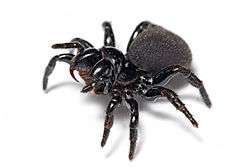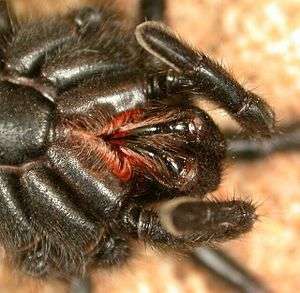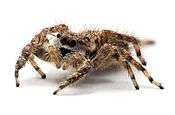Mygalomorphae
The Mygalomorphae, or mygalomorphs, are an infraorder of spiders. The name is derived from the Greek mygalē, meaning "shrew", plus morphē meaning form or shape.[2] An older name for the group is Orthognatha, derived from the orientation of the fangs which point straight down and do not cross each other (as they do in the araneomorphs). In 1802, Charles Athanase Walckenaer separated mygalomorph spiders into a separate genus, Mygale, leaving all other spiders in Aranea.
| Mygalomorphae Temporal range: Triassic to present | |
|---|---|
 | |
| Missulena bradleyi, a mouse spider | |
| Scientific classification | |
| Kingdom: | Animalia |
| Phylum: | Arthropoda |
| Subphylum: | Chelicerata |
| Class: | Arachnida |
| Order: | Araneae |
| Suborder: | Opisthothelae |
| Infraorder: | Mygalomorphae Pocock, 1892[1] |
| Families | |
| Diversity | |
| About 20 families | |
Description
This group of spiders comprises mostly heavy-bodied, stout-legged spiders including tarantulas, Australian funnel-web spiders, mouse spiders, and various families of spiders commonly called trapdoor spiders.
Like the "primitive" suborder of spiders Mesothelae, they have two pairs of book lungs, and downward-pointing chelicerae. Because of this, the two groups were once believed to be closely related. Later it was realized that the common ancestors of all spiders had these features (a state known as symplesiomorphy). Following the branching into the suborders of Mesothelae and Opisthothelae, the mygalomorphs retained them, while their fellow Opisthothelae members, the araneomorphs, evolved new "modern" features, including a cribellum and cross-acting fangs.[3] Mesotheles retain the external abdominal segmentation of ancestral arachnids and have at least vestiges of four pairs of spinnerets, whereas mygalomorphs lack abdominal segmentation (like other opistotheles) and have a reduced number of spinnerets, often only two pairs.[4]
Like spiders in general, most species of Mygalomorphae have eight eyes, one pair of principal and three pairs of secondary eyes.

Their chelicerae and fangs are large and powerful and have ample venom glands that lie entirely within their chelicerae. These weapons, combined with their size and strength, make Mygalomorph spiders powerful predators. Many of these spiders are well adapted to killing other large arthropods and will also sometimes kill small mammals, birds, and reptiles. Despite their fearsome appearance and reputation, most mygalomorph spiders are not harmful to humans, with the exception of the Australian funnel-web spiders, especially those of the genus Atrax.
While the world's biggest spiders are mygalomorphs—Theraphosa blondi has a body length of 10 cm (3.9 in) and a leg span of 28 cm (11 in)—some species are less than one millimeter (0.039 in) long. Mygalomorphs are capable of spinning at least slightly adhesive silk, and some build elaborate capture webs that approach a meter in diameter.[3]
Unlike Araneomorphae, which die after about a year, Mygalomorphae can live for up to 25 years, and some do not reach maturity until they are about six years old.[5] Some flies in the family Acroceridae that are endoparasites of mygalomorphs may remain dormant in their book lungs for as long as 20 years before beginning their development and consuming the spider.
One female trapdoor spider, first recorded in a survey in 1974 in Western Australia, is known to have lived for 43 years.[6]
Taxonomy
Evolution
Megarachne servinei was thought to be a giant mygalomorph from the Upper Carboniferous (about 350 million years ago), but was later found to be a eurypterid.[7] The oldest known mygalomorph is Rosamygale grauvogeli (Hexathelidae) from the Triassic of northeastern France. No mygalomorphs from the Jurassic have yet been found.[8]
The number of families and their relationships have both been undergoing substantial changes since a cladogram showing family relationships was published in 2005,[9] with two significant studies in 2018.[10][11] The division of Mygalomorphae into two superfamilies, Atypoidea and Avicularioidea, has been established in many studies. The Atypoidea retain some vestiges of abdominal segmentation in the form of dorsal tergites; the Avicularioidea lack these. Molecular phylogenetic studies undertaken between 2012 and 2017 have found somewhat different relationships within the Avicularioidea. Some families appear not to be monophyletic and further changes are possible in the future.[4]
Mygalomorphae tend to be very morphologically conserved, which makes it difficult to find reliable morphological features to use in taxonomy. It has been hypothesized that because Mygalomorphae tend to be fossorial and live in tubular webs, they are subjected to similar selective pressures, so most species should evolve in similar ways. Additionally, this may also mean that homoplasies are more likely to occur, further complicating taxonomy based on morphology.[12]
Phylogeny
The relationships of taxa in the Mygalomorphae were restructured based on a comprehensive phylogenetic study by Opatova et al. (2020)[13] The generic composition of the families Ctenizidae, Cyrtaucheniidae, Dipluridae, and Nemesiidae were relimited. Five subfamilies were raised to the rank of family: Anamidae, Euagridae, Ischnothelidae, Pycnothelidae, and Bemmeridae. Three new families were created: Entypesidae, Microhexuridae, and Stasimopidae. Lastly, a new subfamily, Australothelinae, was generated and placed in the family Euagridae.
The preferred cladogram from Optova et al. (2020) is:[13]
| Mygalomorphae |
| ||||||||||||||||||||||||||||||||||||||||||||||||||||||||||||||||||||||||||||||||||||||||||||||||||||||||||||||||||||||||||||||||||||||||||||||||||||||||||||||||||||||||||||||
Families
| Genera | 1 | ≥2 | ≥10 | ≥100 |
| Species | 1–9 | ≥10 | ≥100 | ≥1000 |
Distribution
Most members of this infraorder occur in the tropics and subtropics, but their range can extend farther north, e.g. into the southern and western regions of the United States. Only a few occur in Europe: 12 species from the families Atypidae, Nemesiidae, Ctenizidae, Macrothelidae, Theraphosidae, and Cyrtaucheniidae.
Despite their limited range, currently, it is suggested that the Mygalomorphae were distributed worldwide before the breakup of Pangaea.[8]
References
- Dunlop, Jason A. & Penney, David (2011). "Order Araneae Clerck, 1757" (PDF). In Zhang, Z.-Q. (ed.). Animal biodiversity: An outline of higher-level classification and survey of taxonomic richness. Zootaxa. Auckland, New Zealand: Magnolia Press. ISBN 978-1-86977-850-7. Retrieved 2015-10-31.
- "mygalomorph". Oxford Dictionaries. Archived from the original on 2016-05-21. Retrieved 2016-02-02.
- Coddington, Jonathan A. & Levi, Herbert W. (1991). "Systematics and evolution of spiders (Araneae)". Annual Review of Ecology and Systematics. 22: 565–592. doi:10.1146/annurev.es.22.110191.003025. JSTOR 2097274.
- Wheeler, Ward C.; Coddington, Jonathan A.; Crowley, Louise M.; Dimitrov, Dimitar; Goloboff, Pablo A.; Griswold, Charles E.; et al. (2016). "The spider tree of life: Phylogeny of Araneae based on target-gene analyses from an extensive taxon sampling". Cladistics. 33 (6): 574–616. doi:10.1111/cla.12182.
- "About Spiders". CSIRO. Archived from the original on 2015-09-24. Retrieved 2017-02-18.
- World's oldest spider dies aged 43 in Western Australia Archived 2018-04-29 at the Wayback Machine ABC News, 28 April 2018. Retrieved 2018-04-29.
- Selden, P.A.; Corronca, J.A. & Hünicken, M.A. (2005). "The true identity of the supposed giant fossil spider Megarachne". Biology Letters. 1 (1): 44–48. doi:10.1098/rsbl.2004.0272. PMC 1629066. PMID 17148124.
- Selden, P.A.; da Costa Casado, F. & Vianna Mesquita, M. (2005). "Mygalomorph spiders (Araneae: Dipluridae) from the Lower Cretaceous Crato Lagerstätte, Araripe Basin, north-east Brazil". Palaeontology. 49 (4): 817–826. doi:10.1111/j.1475-4983.2006.00561.x. hdl:1808/8355.
- Coddington, Jonathan A. (2005). "Phylogeny and classification of spiders" (PDF). In Ubick, D.; Paquin, P.; Cushing, P.E. & Roth, V. (eds.). Spiders of North America: an identification manual. American Arachnological Society. pp. 18–24. Retrieved 2015-09-24.CS1 maint: ref=harv (link)
- Hedin, Marshal; Derkarabetian, Shahan; Ramírez, Martín J.; Vink, Cor & Bond, Jason E. (2018). "Phylogenomic reclassification of the world's most venomous spiders (Mygalomorphae, Atracinae), with implications for venom evolution". Scientific Reports. 8 (1): 1636. doi:10.1038/s41598-018-19946-2. PMC 5785998. PMID 29374214.
- Godwin, Rebecca L.; Opatova, Vera; Garrison, Nicole L.; Hamilton, Chris A. & Bond, Jason E. (2018). "Phylogeny of a cosmopolitan family of morphologically conserved trapdoor spiders (Mygalomorphae, Ctenizidae) using Anchored Hybrid Enrichment, with a description of the family, Halonoproctidae (Pocock, 1901)". Molecular Phylogenetics and Evolution. 126: 303–313. doi:10.1016/j.ympev.2018.04.008. ISSN 1055-7903. PMID 29656103.
- Bond, Jason E.; Hedin, Marshal (1 October 2006). "A total evidence assessment of the phylogeny of North American euctenizine trapdoor spiders (Araneae, Mygalomorphae, Cyrtaucheniidae) using Bayesian inference". Molecular Phylogenetics and Evolution. 41 (1): 70–85. doi:10.1016/j.ympev.2006.04.026. ISSN 1055-7903. PMID 16857391.
- Opatova, Vera; Hamilton, Chris A.; Hedin, Marshal; Montes De Oca, Lauren; Král, Jiři; Bond, Jason E. (16 October 2019). "Phylogenetic Systematics and Evolution of the Spider Infraorder Mygalomorphae Using Genomic Scale Data". Systematic Biology. 69 (4): 671–707. doi:10.1093/sysbio/syz064.
- World Spider Catalog (2018), Currently valid spider genera and species.
Notes
- Unless otherwise shown, currently accepted families and counts based on the World Spider Catalog version 19.0 as of 11 July 2018.[14] In the World Spider Catalog, "species" counts include subspecies. Assignment to sub- and infraorders based on Coddington (2005, p. 20) (when given there).
Bibliography
- Raven, R.J. (1985). "The spider infraorder Mygalomorphae: Cladistics and systematics". Bulletin of the American Museum of Natural History. 182: 1–180.
- Goloboff, Pablo A. (23 March 1993). A reanalysis of Mygalomorphae spider families (Araenae) (PDF) (Report). American Museum Novitates. New York, NY: American Museum of Natural History.
External links
| Wikispecies has information related to Mygalomorphae |
| Wikimedia Commons has media related to Mygalomorphae. |
